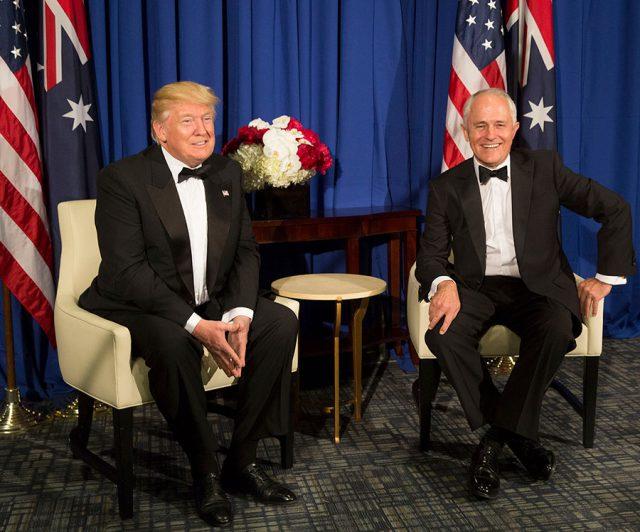
The security treaty between Australia, New Zealand and the United States of America—the ANZUS Treaty—was signed in September 1951 and came into force in April 1952. The treaty was one of a network of security treaties entered into by the US covering the Pacific, including bilateral agreements with the Philippines, Japan, Korea and the Republic of China, as well as the Southeast Asia Collective DefenseTreaty.
In the immediate post–World War II years, the US considered such treaties neither necessary nor desirable, but in 1950 this attitude started to change in response to the rise of communism. Meanwhile, Australia and the US disagreed on the terms of the peace settlement with Japan. The US saw Japan as a potential bulwark against communist expansion and therefore favoured a ‘soft’ peace treaty, enabling Japan to recover economically as quickly as possible.
Australia, on the other hand, had been wary of Japanese aggression since the early 20th century, and wanted a restrictive peace settlement to prevent any recurrence of Japanese imperialism and militarism. A peace settlement that permitted Japan to rearm made it all the more important for Australia that there be a security arrangement for the Pacific.
In 1950 these two issues—the peace terms and a Pacific pact—began to converge in discussions between the US and Australia, and ultimately in 1951 the ANZUS treaty was concluded. It was signed within days of the multilateral peace treaty with Japan.
The ANZUS treaty was largely based on the 1949 NATO treaty, but the NATO treaty contains a clearer collective defence obligation in article 5, declaring an attack on one to be an attack on all, and requiring parties to assist the victim state. The ANZUS treaty contains less specific language in article IV:
Each Party recognizes that an armed attack in the Pacific Area on any of the Parties would be dangerous to its own peace and safety and declares that it would act to meet the common danger in accordance with its constitutional processes.
The US Congress had been reluctant to ratify the NATO agreement because it appeared to bypass the right of Congress to declare war, so less specific language was used in the ANZUS treaty, and an express reference to internal constitutional processes was added. Notwithstanding this, the substance of the two provisions is virtually identical.
The effect of the NATO article 5 is that if there’s an armed attack against one of the parties, each of the others must decide what if any action to take to assist the victim state, and this can include deciding to take no action at all. The effect of the ANZUS article IV is that if there’s an armed attack against one of the parties, the others must take action. Both provisions leave it to the individual states to determine what action to take, ranging from no action (NATO) or minimal action (ANZUS), through to armed force.
The obligation to act arises only if there’s an ‘armed attack’. The International Court of Justice has affirmed in several cases that an ‘armed attack’ is more than just any use of force. It must be of sufficient scale and effect to amount to the ‘most grave’ use of force. The attack must be ‘in the Pacific Area’, which isn’t defined.
Some guidance is given in article V, which specifies that article IV applies to an armed attack on ‘the metropolitan territory of any of the Parties, or on the island territories under its jurisdiction in the Pacific or on its armed forces, public vessels or aircraft in the Pacific’. Thus, the treaty covers at least an armed attack on mainland Australia, New Zealand and the US, and islands such as Guam.
Would it apply in a confrontation between the US and North Korea? As is well known, the ANZUS treaty has only been formally invoked once, following the terrorist attacks in the United States in September 2001. But the current prime minister, Malcolm Turnbull, has pledged that Australia would again invoke the treaty if there were an attack on the US by North Korea.
As a matter of treaty interpretation, article IV of the treaty would be enlivened if North Korea used sufficient force against US territory (whether on the mainland or in the Pacific), or against US troops, vessels or aircraft in the Pacific. But if the US were to launch a pre-emptive strike, North Korea could legitimately justify a proportionate use of force in response as lawful self-defence. Thus article IV wouldn’t apply if North Korea’s use of force was either in lawful self-defence against an armed attack by the US, or of insufficient gravity to amount to an ‘armed attack’.
The key question is what article IV actually requires. The only legal obligation under article IV is to ‘act’, and Australia could satisfy this obligation in a range of ways—from informal representations through to the full-blown use of force.
What’s clear is that if force is used, the parameters of self-defence dictate that the force used be no more than is necessary and proportionate in the circumstances. Quite what that might entail in a nuclear conflict is impossible to assess in advance.